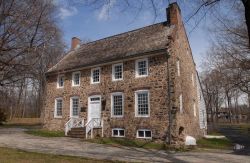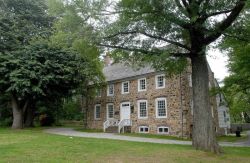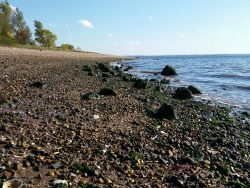Conference House Park
Conference House
Conference House, the 17th century manor house on this southernmost tip of Staten Island, was named after a dramatic meeting that shaped the history of the United States.
Long before Europeans settled this land, there was a strong Native American association with this site. The Lene Lenape Indians used this area, particularly the bluff, as a seasonal settlement. They traveled up and down the East Coast from the New York Harbor to the Delaware River basin, oystering, fishing, hunting, and trading. At one time, animals such as deer, turkeys, heath hen, black bears, beavers, wolves, red and gray foxes were plentiful in this region. The Lene Lenape also used the bluff as a burial ground, perhaps on the site of a burial ground previously established by a prehistoric culture.
In 1676, British naval captain Christopher Billopp (the surname has also been spelled as “Billop,” “Billupp” and a number of other variations) was granted 932 acres of property, known as the Manor of Bentley. Billopp built this house, a solid, two-story structure of native fieldstone, ca. 1680. By 1687, he had increased his land holdings to 1,600 acres, and enlarged the house in 1720. According to legend, Captain Billopp secured Staten Island for New York State by winning a bet between New York and New Jersey that he could sail all the way around the borough in one day.
During the American Revolution the owner of the manor was Captain Billopp’s great-grandson, also named Christopher Billopp. A colonel in the British (or Tory) army, Billopp sometimes entertained his fellow soldiers in this house. On September 11, 1776, this house was the site of a conference between British Lord Admiral Richard Howe and Founding Fathers Benjamin Franklin, John Adams, and Edward Rutledge. The talks occurred just two months after the Declaration of Independence had been signed. With the British controlling New York City, Long Island, and Staten Island, the Americans seemed headed for defeat. Lord Howe offered to end the conflict peacefully if the American colonies would return to British control, but the Americans refused to give up their struggle for independence. Franklin, Adams, and Rutledge reported back to the Continental Congress in Philadelphia, and the Revolution continued for another seven years until American independence was finally won.
Being a Tory and the commander of a provincial corps, Billopp was captured twice during the war, once in 1778 for nine months and again in 1779 for a month. By 1780, Billopp had begun selling off parcels of his land. Before the war’s end he managed to sell 850 of his 1,600 acres, including the manor house which he sold to Samuel Ward, along with 373 acres. The rest of Colonel Billopp’s property was confiscated after the war and, like many loyalists, Billopp moved to Canada. The last family to own this house was the Ward family. In May of 1781, Samuel Ward, a Staten Island farmer, purchased the largest of the nine farms into which Billopp’s property had been divided from Christopher Billopp. When Samuel Ward died in 1813, his son Caleb took over the property. Caleb Ward and his wife Mary lived in the house with their five children until Caleb’s death in 1834 or 1835.
Located on Hylan Boulevard, the house then served as a multi-family dwelling, a 19th-century travelers inn, and as a rat-poison manufacturing site before being deeded to the City of New York in 1926. In 1929 the Conference House Association took over operation of the house and has maintained it since then, in cooperation with the City of New York / Parks & Recreation and the Historic House Trust of New York City. Today, Conference House is a historic site portraying life in colonial times situated on a 3.27-acre plot of Conference House Park.
Check out your park's Vital Signs
Clean & Safe
Green & Resilient
Empowered & Engaged Users
Share your feedback or learn more about how this park is part of a
Vital Park System
Downloads
Contacts
Visitors Center: (718) 227-1403










